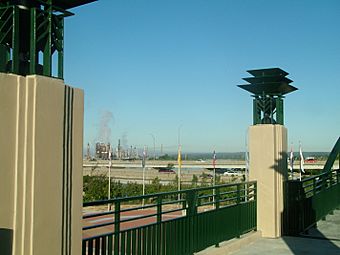11th Street Bridge facts for kids
Quick facts for kids |
|
|
11th Street Bridge
|
|
 |
|
| Location | Tulsa, Oklahoma |
|---|---|
| Built | 1915 |
| Architect | Harrington, Howard and Ash |
| NRHP reference No. | 96001488 |
| Added to NRHP | 1996 |
The 11th Street Bridge is a historic bridge in Tulsa, Oklahoma. It was finished in December 1915. This bridge was built to help cars cross the Arkansas River. From 1916 to 1972, it was an important part of the famous U.S. Route 66.
Today, the bridge is not safe to use. It is in very poor condition. Even people walking are not allowed on it. Since 2008, the gates have been locked to keep everyone off. In 1996, the bridge was added to the National Register of Historic Places. This means it is a special historical landmark. In 2004, it was given a new name: the "Cyrus Avery Route 66 Memorial Bridge." This was to honor a man who helped create Route 66.
Contents
Building the Bridge
This bridge was designed by a company called Harrington, Howard and Ash from Kansas City. It replaced an older bridge made of wood. The Missouri Valley Bridge and Iron Company built it for $180,000.
The 11th Street Bridge is a long bridge made of concrete arches. It has 18 sections, or spans. It is about 1,470 feet (450 m) long and 34 feet (10 m) wide. When it was first built, it had a train track in the middle. There was one lane for cars on each side of the track.
This bridge was special for a few reasons:
- It was the first bridge built for cars to cross the Arkansas River.
- It was one of the longest concrete structures in the middle of the United States.
- It was the first concrete bridge with many sections built in Oklahoma.
In 1929, some parts of the bridge were changed. The old railings and lights were replaced. New railings and lights in the Art Deco style were added. Art Deco is a cool design style from the 1920s and 1930s.
In 1934, another arched bridge was built right next to it. Both bridges were then connected with one big deck. This made the bridge much wider, about 40 feet (12 m) across. It could then hold four lanes of traffic.
Why the Bridge Was Replaced
In 1967, new bridges for I-244 were finished. Most cars started using these new bridges instead of the 11th Street Bridge. This meant the old bridge was not needed as much.
In 1980, the 11th Street Bridge was closed to cars. However, people could still walk on it. As mentioned, it was added to the National Register of Historic Places in 1996. In 2004, the city of Tulsa, Oklahoma officially renamed it the Cyrus Avery Route 66 Memorial Bridge. This was to honor Cyrus Avery, who worked hard to make Route 66 happen.
Current Condition of the Bridge
The old bridge has become very worn out over time. The city of Tulsa says it is "quite dangerous" and not safe for anyone. There are holes in the bridge deck, and the pavement is bumpy. Weeds even grow in the cracks.
Because it was so unsafe, the gates were locked in 2008. There were ideas to make it a main part of a Route 66 display. But engineers said it would cost about $15 million just to make it safe for people to walk on. So, people decided that the historic bridge is "too expensive to repair, too historic to demolish, and too valuable to ignore."
Interestingly, the I-244 bridges that replaced the 11th Street Bridge are also old now. One of the I-244 bridges was closed and taken down starting in 2011. It is being replaced with a new double-deck bridge. The top part will be for cars. The bottom part will have a path for walkers and two train tracks for the future.
Cyrus Avery Centennial Plaza
The fact that Tulsa already had a bridge over the Arkansas River was a big reason why U.S. Route 66 was built through the city. To remember Route 66 and the man who helped create it, the Cyrus Avery Centennial Plaza was built. It is near the east side of the historic bridge in Tulsa.
The first part of the plaza was finished in 2008. It has flags from the eight states that Route 66 passed through. There is also a skyway with a viewing area. This lets people walk from the parking lot over the road to the plaza.
The plaza also has a large bronze sculpture called "East Meets West." It was made by artist Robert Summers. The sculpture is 14 feet (4.3 m) long, 18 feet (5.5 m) wide, and 14 feet (4.3 m) high. It shows the Avery family riding west in an old Model T Ford car. They are meeting a horse-drawn carriage going east. This huge sculpture weighs over 20,000 pounds (9,100 kg) and cost about $1.178 million.
In 2020, a new part of the plaza, called Avery Plaza Southwest, was planned to open on the west side of the bridge. It will have copies of old neon signs from Tulsa motels from the Route 66 era.
Proposed Museum
There is also an idea to build a museum. This museum would teach visitors about the history and importance of Route 66. It would be built on a hill next to the plaza's parking lot. However, no date has been set for when this project might start.

